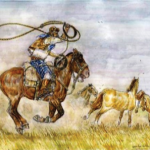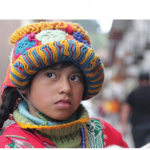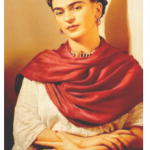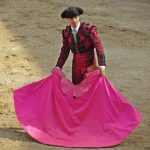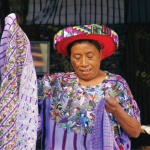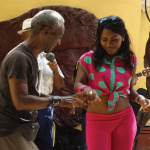Unidad 2: De compras y la ropa
13. Apliquemos los conceptos con unas prendas tradicionales
Feria cultural

You are helping at a cultural fair (una feria cultural) with representatives from various countries that will demonstrate traditional clothing as part of the festivities. Translate the sentences below using the structures that support the subjunctive formula and constructions.
- For the cultural fair, we need the girl from Perú to wear the pink, orange and blue hat. __________________________________________________________________________________________
- It is good that the lady from México brings her “rebozo”. Do you know who is she? _____________________________________________________________________________________________
- We hope the man with the hat from Argentina rides the horse. The man is a gaucho. _____________________________________________________________________________________________
- It is important to show the “torero” (bullfighter) with the traditional clothing, “ traje de luces”, and his long pink cape “capa”. ______________________________________________________________________________________________
- They want the couple from Cuba, the man with his black outfit and the woman with her pink with blue polka-dotted clothing, to dance. ______________________________________________________________________________________________
- It is necessary that the women from Guatemala put on the traditional blouses (the huipil) with the beautiful patterns. _______________________________________________________________________________________
Based on the clues in the sentences you just translated, write the name of the country below the photo that is represented. There is an extra photo but you may know the origin of this person already.
- ________________
- ________________
- ________________
- ________________
- ________________
- ________________
- ________________
Analicemos–Now let’s analyze the next sentences using everything that we have learned about sentences, moods and tenses.
Pepe estudia español
- ¿Cuántos verbos conjugados hay?___________________________________
- ¿Cuál es la acción en la oración? ____________________________________
- ¿Quién (es el sujeto que hace la acción) estudia? _______________________________
- ¿La oración es un hecho, una orden, un sentimiento? ____________________________
- ¿Cuál es el modo?________________________________________
- ¿Cuándo ocurre (happens) la acción? _______________________________
La maestra quiere que los estudiantes estudien
- ¿Cuántos verbos conjugados hay?______________________________
- ¿Cuál es la acción de la primera claúsula? ______________________________
- ¿Cuál es el sujeto de la primera claúsula? ¿Quién quiere? ________________________
- Para la profe quiere ¿un hecho, una orden o un sentimiento? ______________________
- ¿Cuál es el modo de la primera claúsula? _______________________________
- What is the conjunction that is the link for the second clause? ______________________
- ¿Cuál es la acción de la segunda oración? _____________________________
- ¿Cuál es el sujeto de la segunda oración? ¿Quién debe estudiar? ____________________
- La profe, ¿Qué desea o qué quiere que nosotros hagamos? ______________________ (El deseo no es para ella, el deseo es para nosotros)
- ¿Cuál es el modo de la segunda oración? _____________________________

¡10 cosas que son importantes de recordar!
- The verb is the action; it is the most important component in the sentence.
- We have a sentence only when we have a conjugated verb.
- The subject is the person (first, second, third person singular or plural) that does the action (verb).
- All conjugated verbs in Spanish tell us who the person is that does the action (first, second, Third à the subject)
- All conjugated verbs tell us the attitude of the speaker toward what he or she is saying. If the speaker is talking about facts (Indicative Mood), Orders (Imperative Mood) or feelings toward the actions of another (Subjunctive Mood).
- Each mood has its own tenses, only the Imperative Mood has one tense (present).
- The difference between indicative and subjunctive is the difference between certainty/objectivity (indicative) and possibility/subjectivity (subjunctive).
- The subjunctive habitually contains a main clause to warrant the use of the subjunctive. The main clause can be in the Indicative Mood or Imperative Mood.
- The subjunctive mood can be in a declarative, exclamatory or interrogative sentence.
- Usually the main clause and the second clause are linked with the conjunction “que.” There are a few exceptions which we will study later.

